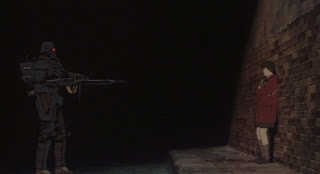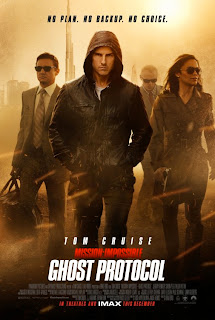Japanese animation director
Mamoru Oshii is probably most famous for his two feature length adaptations of Ghost in the Shell and Ghost in the Shell 2: Innocence. But
he’s worked on quite a few other projects, including some live action films and
screenwriting. In 1999 one of his scripts was adapted into a feature length
animated film that many felt was a game changer for anime – finally bringing it
to the mainstream. But we’d all heard that story before.
Summary:
The story occurs during the late
1950s in a world (including Japan) that has lost World War II to the Germans. Japan is ruled like
a police state, and the people are rising up attempting to buck off the harsh
rule. To quell the protests Japan creates a special police force (since they
are not permitted an army) known as the Capital Police. These heavily armed
teams are permitted to act with extreme measures to ensure public safety. Within
this force is a secret counter intelligence unit, known as the wolf brigade. It
is their job to ensure that the Capita Police retain the power they have within
the political organization.
We meet Kazuki Fuse (Michael
Dobson) a member of the Capital police who finds himself in a bit of a mess.
During an operation that involved eliminating members of a militant group called
The Sect, Fuse comes face to face with a pretty young girl. Dressed in a red
coat and obviously transporting a bomb, she is cornered by Fuse. He tries to
reason with her, unable to just kill her outright, as he is ordered to. Instead
the girl blows herself up in front of him.
Now Fuse is being
investigated for his inaction. He’s being watched by organizations within the
government – did he act out of compassion, or is there something else going on?
He eventually meets Kei Anemiya (Moneca Stori) a young woman who looks a lot
like the girl he watched die. They become fast friends, as Fuse attempts to
reconcile what he’s done. But even Kei is not what she appears. The stakes are
raised as the Capital Police’s function is questioned. In the end Jin-Roh: The Wolf Brigade will be forced to act and Fuse will be
caught in the crossfire.
Good Points:
- Amazing animation and backgrounds
- Period and technical details are impressive
- A moody musical score by Hajime Mizoguchi
Bad Points:
- Deliberately paced
- The political machinations require close attention
- The film is very morose and dark
Overall:
From an animation
standpoint, Jin-Roh is an impressive
piece of work. The design and execution of the visuals is some of the best from
the 1990s, and from hand drawn animation. But the story itself is dreary and
dark. Combine this with the entire atmosphere from the visuals and music, and
the slow pacing and you end up with a movie that isn’t entertaining. It’s a
slog to make it through, but it delivers an emotional punch at the end.
Scores
(out of 5)
Visuals: 5
Sound: 4
Acting: 4
Script: 4
Music: 4
Direction: 3
Entertainment: 2
Total: 4
In Depth Review
 |
| The wolf finds red riding hood. |
Let me qualify something
here. I don’t mind tragic stories. I enjoy the power behind them, and
understand how they can be very effective entertainment. In fact some of my
favorite films are tragic in their nature. When it comes to Shakespeare, I find
his tragedies much more engaging than his comedies. I love horror films (which
are based on the tragedy mold). But there is something missing in Jin-Roh that turns it from tragic and
into nihilistic.
Lets look at the good points.
There are many and that is the reason I can’t write this film off. The
animation is extremely impressive. Set in an alternate version of the 1950s, we
get a view of Post War Japan that is very detailed and authentic. The cars,
clothing and hairstyles reflect the time period and pull you into the world
director Hiroyuki Okura creates.
In addition, the mechanical
design for the weapons and armor used by the Capital police looks fully
functional, and realistic. The helmets recall German design. The heavy armor,
glowing night vision scopes and heavy weaponry not only appear realistic, but also
intimidating as hell. To see these soldiers coming toward you means certain
death.
 |
| A very realistic post war Japan |
The action scenes are some
of the best I’ve seen. There are three set pieces, each one fluid, violent and
intense. The way the armored troops move feels authentic. Later when one man
attempts to take out a group of several armed guards, his motions are very
realistic. The animators never shy from showing us all the moves, all the
violence and the blood that these encounters create. Jin-Roh is a violent world.
Overlaid on all of this is
the atmosphere of control, repression and despair. Nearly every scene in the
film occurs during the night, dusk or early dawn. The sun rarely appears, and
even when it does, the days are cloudy or rainy. There's a dusty color scheme to everything. It makes the visuals appear soft and faded like an old photograph. Visually, it’s a murky miserable world. And while some of the characters speak of hope, or of times
changing – the visual cues are quite the opposite. It’s an oppressive mood,
effectively created.
The realism also spreads to
the sound design. Most of the film occurs in Tokyo, and you get plenty of crowd
and traffic noise. But even quieter moments are well defined with gentle wind
or rain adding to the overall film.
 |
| Turmoil rages in the streets. Order must be maintained. |
I have to say the English
voice acting is pretty solid. Dobson plays Fuse pretty close to the chest. This
makes sense for the character, and also ties into the fact that Fuse doesn’t
have a lot to say. Most of the character is developed through is actions and
his reactions. Instead Stori gets most of the heavy lifting in her role as
Amemiya. She has lots of one-sided conversations and develops a character that
has several layers. The supporting cast does a good job with their parts,
giving us various shades of grey to work with.
The script by Oshii is based
on a series of movies, manga and radio dramas he worked on in the late 80s and
early 90s. He created the world of Jin-Roh,
including the Capital Police and the back-story that lead to their creation.
This film doesn’t assume you’ve seen or heard any of the previous stories. And
the first few minutes of the film are pretty much an info dump of history
leading up to the events of the film.
 |
| Is she befriending a man or a wolf? |
Then you have the two young
girls who feature prominently in the story. Both wear red jackets with hoods.
Both connect with the “wolf” on some level. Both wander into the dark dangerous
inner working of the city. And both face fear. The outcomes are very different
from each other (and from the original fairy tale). But the theme is obvious.
It is interesting that Oshii
was exploring this theme of a strong military that de-humanizes it’s soldiers
to fight terrorists, a few years before world events really put a spotlight on
this aspect of war. Not surprisingly, Jin-Roh
was released in North America in 2002, two years after it’s premiere. It’s
one of those things that may have made the film more relevant to anime fans at
the time, and lead to the highly favorable reviews of the film upon its
release.
 |
| The real motivators in the film. |
Even though Oshii didn’t
direct Jin-Roh, Hiroyuki Okiura does
keep Oshii’s pacing in mind. The film moves very slowly, allowing the viewer to
absorb the wonderful animation and become immersed in the atmosphere. At the
same time, the tension that should be building often feels lost among the
turgid meandering. I feel the movie needed to deliver its final gut punch with
more speed and power. Instead, the movie ends with tragedy, but it’s taken so
long to get there that we are just left feeling that all the depression up to
that point couldn’t end in any other way. It’s not a surprise really; it just feels
like a natural extension of this dark world.
 |
| A pack of wolves. |









